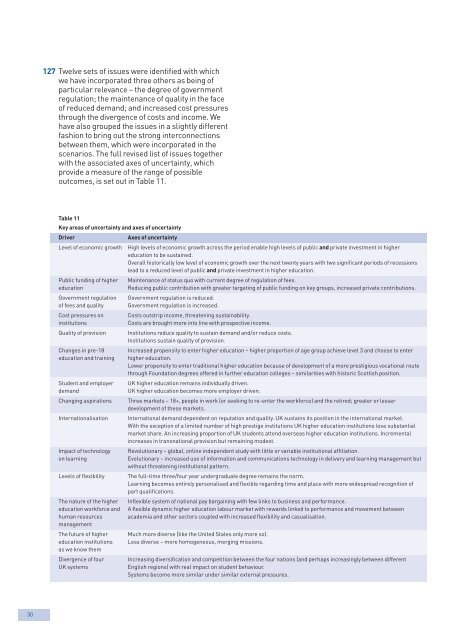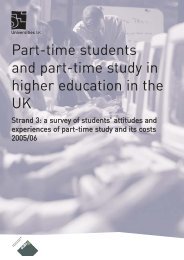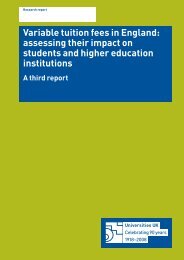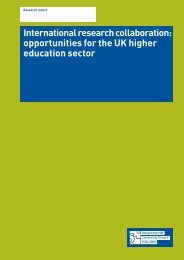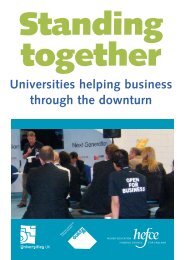The future size and shape of HE - Universities UK
The future size and shape of HE - Universities UK
The future size and shape of HE - Universities UK
- No tags were found...
You also want an ePaper? Increase the reach of your titles
YUMPU automatically turns print PDFs into web optimized ePapers that Google loves.
127 Twelve sets <strong>of</strong> issues were identified with whichwe have incorporated three others as being <strong>of</strong>particular relevance – the degree <strong>of</strong> governmentregulation; the maintenance <strong>of</strong> quality in the face<strong>of</strong> reduced dem<strong>and</strong>; <strong>and</strong> increased cost pressuresthrough the divergence <strong>of</strong> costs <strong>and</strong> income. Wehave also grouped the issues in a slightly differentfashion to bring out the strong interconnectionsbetween them, which were incorporated in thescenarios. <strong>The</strong> full revised list <strong>of</strong> issues togetherwith the associated axes <strong>of</strong> uncertainty, whichprovide a measure <strong>of</strong> the range <strong>of</strong> possibleoutcomes, is set out in Table 11.Table 11Key areas <strong>of</strong> uncertainty <strong>and</strong> axes <strong>of</strong> uncertaintyDriverAxes <strong>of</strong> uncertaintyLevel <strong>of</strong> economic growth High levels <strong>of</strong> economic growth across the period enable high levels <strong>of</strong> public <strong>and</strong> private investment in highereducation to be sustained.Overall historically low level <strong>of</strong> economic growth over the next twenty years with two significant periods <strong>of</strong> recessionslead to a reduced level <strong>of</strong> public <strong>and</strong> private investment in higher education.Public funding <strong>of</strong> higher Maintenance <strong>of</strong> status quo with current degree <strong>of</strong> regulation <strong>of</strong> fees.educationReducing public contribution with greater targeting <strong>of</strong> public funding on key groups, increased private contributions.Government regulation Government regulation is reduced.<strong>of</strong> fees <strong>and</strong> quality Government regulation is increased.Cost pressures on Costs outstrip income, threatening sustainability.institutionsCosts are brought more into line with prospective income.Quality <strong>of</strong> provision Institutions reduce quality to sustain dem<strong>and</strong> <strong>and</strong>/or reduce costs.Institutions sustain quality <strong>of</strong> provision.Changes in pre-18 Increased propensity to enter higher education – higher proportion <strong>of</strong> age group achieve level 3 <strong>and</strong> choose to entereducation <strong>and</strong> training higher education.Lower propensity to enter traditional higher education because <strong>of</strong> development <strong>of</strong> a more prestigious vocational routethrough Foundation degrees <strong>of</strong>fered in further education colleges – similarities with historic Scottish position.Student <strong>and</strong> employer <strong>UK</strong> higher education remains individually driven.dem<strong>and</strong><strong>UK</strong> higher education becomes more employer driven.Changing aspirations Three markets – 18+, people in work (or seeking to re-enter the workforce) <strong>and</strong> the retired; greater or lesserdevelopment <strong>of</strong> these markets.Internationalisation International dem<strong>and</strong> dependent on reputation <strong>and</strong> quality. <strong>UK</strong> sustains its position in the international market.With the exception <strong>of</strong> a limited number <strong>of</strong> high prestige institutions <strong>UK</strong> higher education institutions lose substantialmarket share. An increasing proportion <strong>of</strong> <strong>UK</strong> students attend overseas higher education institutions. Incrementalincreases in transnational provision but remaining modest.Impact <strong>of</strong> technology Revolutionary – global, online independent study with little or variable institutional affiliation.on learningEvolutionary – increased use <strong>of</strong> information <strong>and</strong> communications technology in delivery <strong>and</strong> learning management butwithout threatening institutional pattern.Levels <strong>of</strong> flexibility <strong>The</strong> full-time three/four year undergraduate degree remains the norm.Learning becomes entirely personalised <strong>and</strong> flexible regarding time <strong>and</strong> place with more widespread recognition <strong>of</strong>part qualifications.<strong>The</strong> nature <strong>of</strong> the higher Inflexible system <strong>of</strong> national pay bargaining with few links to business <strong>and</strong> performance.education workforce <strong>and</strong> A flexible dynamic higher education labour market with rewards linked to performance <strong>and</strong> movement betweenhuman resources academia <strong>and</strong> other sectors coupled with increased flexibility <strong>and</strong> casualisation.management<strong>The</strong> <strong>future</strong> <strong>of</strong> higher Much more diverse (like the United States only more so).education institutions Less diverse – more homogeneous, merging missions.as we know themDivergence <strong>of</strong> four Increasing diversification <strong>and</strong> competition between the four nations (<strong>and</strong> perhaps increasingly between different<strong>UK</strong> systemsEnglish regions) with real impact on student behaviour.Systems become more similar under similar external pressures.30


